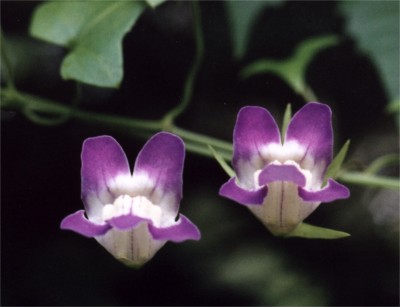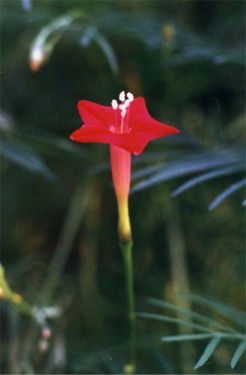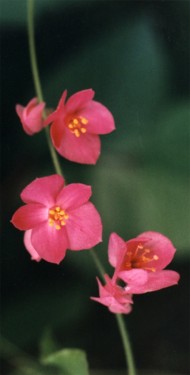Slender Vines
by Valerie (August 12, 2000)
|
Vines are generally a graceful plant, with their tendrils and long curling stems. While some vines are very robust and thick-stemmed, there are others that seem rather delicate, with leaves and blossoms supported by wiry thin stems.

The snapdragon vine (Maurandya antirrhiniflora) is a perennial native wildflower in this area. It is slightly resistant to droughts, but will lose a lot of leaves if not watered. The leaves are very angular, light green and small. They look a lot like ivy leaves. True to its name, the flowers of the snapdragon vine resemble those of the related garden snapdragon. They are always a pleasant shade of purple and white, and usually appear sparsely, but certain weather conditions can make it bloom more prolifically (but it doesn't happen for us very often). Although the plant is small, it manages to grow quite well along with larger vines on a fence and its tiny leaves are interspersed with all the other species. For brilliant color, the cypress vine (Ipomoea quamoclit), or cardinal climber, is a real favorite. This very delicate annual vine requires a lot of extra water and so doesn't do too well for us, although I try to give it extra attention. We are also rather unsuccessful in getting it to reseed, but the seeds do sometimes sprout in the lawn. The name comes from the leaves of the vine, which are bright green and feathery, just like those of the cypress tree. When the plant isn't too heat-stressed, it has absolutely brilliant scarlet flowers. The flowers and the seeds resemble the related morning glory, but are much smaller. In a complete clash of color, the coral vine (Antigonon leptopus) has hot pink blossoms. There is at least one more vine also called a coral vine, but it is not related. Other names for this plant are chain of love and queen's wreath. This plant, although rather small, is a hardy perennial, able to withstand the heat and lack of water. Its leaves are slightly angular and heart-shaped and the flowers grow out along the leading stems for several inches. The blossoms last for several days, so the vine can be very colorful when it is laden with lots of flowers. Although our vines don't grow very aggressively, there are places around Austin where these plants cover fences, light poles and utility wires. The leaves of our coral vines are often laced with circular holes, cut out by leafcutter bees, which seem to prefer this plant to most others. I have even seen a bee in the act of cutting out a segment (they work very quickly), which it would then take back to its nest in a hole in the ground, most likely in an area of our front yard where I've watched the bees coming and going from their individual burrows. |

